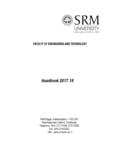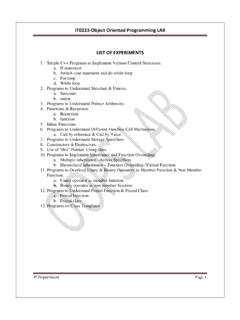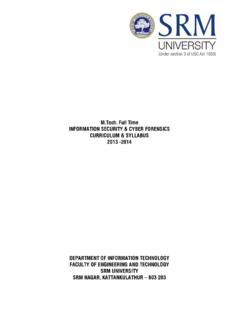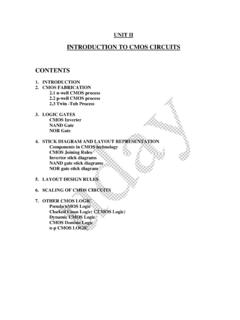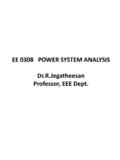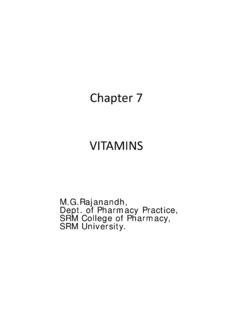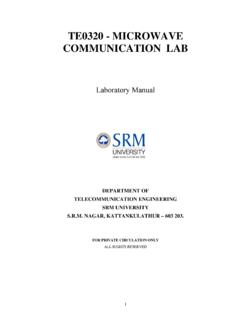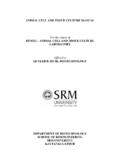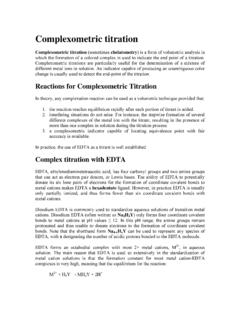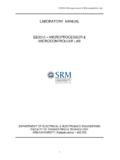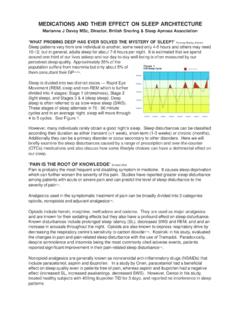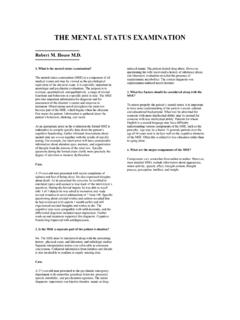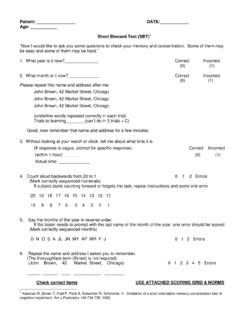Transcription of Cholinergics and Anticholinergics - India’s Premier ...
1 Cholinergics and Anti cholinergicsPHL-358-PHARMACOLOGY AND THERAPEUTICS-IMr. , ,LecturerCholinergic Drugs Parasympathomimetics or cholinomimetics Stimulate parasympathetic nervous system in same manner as does acetylcholine May stimulate cholinergic receptors directly or slow acetylcholine metabolism at synapses (affect the enzyme acetylcholinesterase)Cholinergic Drugs Useful in treating alzheimer s Disease, Myasthenia gravis and to tx atony of the smooth muscle of the GI system or urinary systemCholinergic Drugs Normal neuromuscular function, acetylcholine binds to nicotinic receptors on cell membranes of muscle cells to cause contraction Myasthenia gravis autoantibodies presumably destroy nicotinic receptors; thus, acetylcholine less able to stimulate muscle contraction.
2 Results in severe muscle Drugs Acetylcholine important neurotransmitter affecting cognitive functioning, memory storage and retrieval In alzheimer s disease (AD), abnormalities of the cholinergic, serotonergic, noradrenergic, and glutaminergic neurotransmission systems In cholinergic system, patient with AD found to have loss of neurons that secrete acetylcholineCholinergic Drugs GI effects Acetylcholine stimulates cholinergic receptors in the gut to promote normal secretory and motor activity Cholinergic activity in the gut will increase peristalsis and facilitates movement of flatus and feces The secretory functions of the salivary and gastric glands also stimulatedCholinergic Drugs GU effects Acetylcholine stimulates cholinergic receptors in the urinary system to promote urination Results in contraction of the detrusor muscle and
3 Relaxation of the urinary sphincter to facilitate emptying of the urinary bladderAcetylcholine One of the main neurotransmitters of the ANS is acetylcholine Acetylcholine is released at preganglionic fibers of both the sympathetic and parasympathetic nervous system Also released from postganglionic sympathetic neurons that innervate the sweat glands and from motor neurons that innervate the skeletal musclesAcetylcholine Sympathetic and parasympathetic divisions of the ANS are antagonistic to each other When acetylcholine acts on body cells that respond to parasympathetic stimulation, it interacts with two types of cholinergic receptors: nicotinic and muscarinicAcetylcholine Nicotinic receptors are located in motor nerves and skeletal muscle Stimulation results in muscle contractionAcetylcholine Muscarinic receptors are located in most internal organs.
4 This includes the cardiovascular, respiratory, gastrointestinal, and genitourinary. Stimulation of the muscarinic receptors may result in either excitation or inhibition, depending on the organ of Action Direct Acting Cholinergics Direct acting cholinergicsare lipid insoluble Do not readily enter the CNS so effects are peripheral Resistant to metabolism by acetylcholinesterase Effects are longer acting than with acetylcholineDirect Acting Cholinergic Drugs cont. Widespread systemic effects when they combine with muscarinic receptors in cardiac muscle, smooth muscle, exocrine glands and the eyeDirect acting Cholinergic DrugsEffects Decreased heart rate, vasodilation, variable BP effects Increased tone and contractility in GI smooth muscle, relaxation of sphincters, increased salivary gland and GI secretions Increased tone and contractility of smooth muscle in urinary bladder and relaxation of the sphincterDirect Acting Cholinergic Drugs cont.
5 Increased tone and contractility of bronchial smooth muscle Increased respiratory secretions Constriction of pupils (miosis) and contraction of ciliary muscleDirect Acting Cholinergics Bethanecol (Urecholine) given orally. Not given IM or IV. Used to treat urinary retention due to bladder atony and for postoperative abdominal distention due to paralytic ileusIndirect Acting Cholinergic Drugs Action is by decreasing the inactivation of acetylcholine in the synapse by the enzyme acetylcholinesterase Accumulation of acetylcholine then occurs which enhances the activation of the nicotinic and muscarinic receptorsIndirect Acting or Anticholinesterase Drugs cont.
6 Anticholinesterase drugs are either reversible or irreversible inhibitors of acetylcholinesterase Reversible agents are such drugs as:edrophodium (Tensilon). Used to diagnose myasthenia gravis and for reversal of non depolarizing neuromuscular blockersIndirect acting agents cont. Neostigmine (Prostigmine) prototype anticholinesterase agent. Used for long term tx of myasthenia gravis and as an antidote for tubocurarine and other non depolarizing agents in surgery. Poorly absorbed orally so requires larger doses than when given parenterally. Can develop resistance to its action over timeIndirect Acting Agents Pyridostigmine (Mestinon) is the maintenance drug of choice for patients with Myasthenia gravis.
7 Slow release. Indirect Acting Reversible cont. Physostigmine (Antilirium) only anticholinesterase capable of crossing the blood brain barrier. Is more lipid soluble. Used as an antidote for overdosage of Anticholinergics such as: atropine, antihistamines, TCA, phenothiazines. May also be used in tx of Acting Agents used to treat alzheimer s disease Donepezil (Aricept) said to delay progression of the disease by up to 55 weeks. Does not cause liver toxicity. Galantamine (Reminyl) newest kid on the block Rivastigmine (Exelon) long acting. Twice a day dosing.
8 Tacrine (Cognex) hepatoxic. Elevated liver enzymes usu. Within 18 wks. > in Conditions Distinction between cholinergic crisis and a myasthenic crisis Difficult to ascertain as both are characterized by respiratory difficulty or failure Need to distinguish as require opposite treatment measuresSpecific Conditions Cholinergic vs. Myasthenic Crisis Myasthenic crisis requires more anticholinesterase drug whereas cholinergic crisis requires discontinuation of the anticholinesterase drugs Diagnosis can be made by evaluating patient patient response to their medication (s/s one hour after medication often is cholinergic crisis, s/s 3 or more hours after medication often is myasthenic crisisMyasthenia Gravis If s/s not clearly indicative of the problem, may have to intubate patient, inject dose of IV edrophonium.)
9 If dramatic improvement in breathing, diagnosis is myasthenic crisis. If edrophonium makes s/s worse, the diagnosis is cholinergic crisis. Patient must be intubated and assisted with mechanical ventilation to perform this of Cholinergic Drugs Atropine is the specific antidote to cholinergic agents Atropine reverses only the muscarinic effects of cholinergic drugs; heart, smooth muscle, and glands. Atropine cannot reverse the nicotinic effects of skeletal muscle weakness or paralysis due to overdose of indirect cholinergic of Irreversible Anticholinesterase Agents These agents are lipid soluble Can enter the body by the eye,skin, respiratory system and GI tract.
10 Case in point, organophosphate insecticides (malathion, parathion) or nerve gases (sarin, tabun, soman) These agents cause excessive cholinergic stimulation (muscarinic) and neuromuscular blockadeAnticholinergics Also called cholinergic blocking agents or parasympatholytics Again, focus is on the parasympathetic nervous system Parasympathetic system acts as a resting and reparative function Functions include digestion, excretion, cardiac decelertion, anabolism and near visionParasympathetic Nervous System 75% of all parasympathetic nerve fibers are in the vagus nerves These nerves supply the thoracic and abdominal organs, which innervate the heart, lungs, esophagus, stomach, small intestine.
